英语人教版九年级全册unit13教案
- 格式:pdf
- 大小:29.98 KB
- 文档页数:5
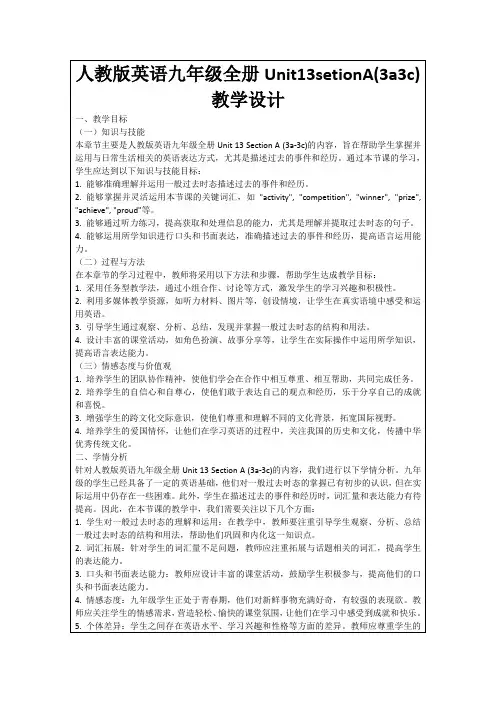
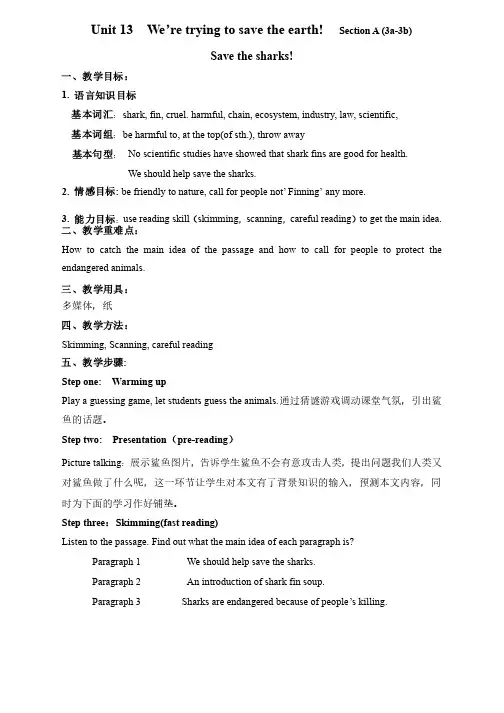
Unit 13 We We’’re trying to save the earth!Section A (3a-3b) Save the sharks!一、教学目标:1. 语言知识目标基本词汇:shark, fin, cruel. harmful, chain, ecosystem, industry, law, scientific, 基本词组:be harmful to, at the top(of sth.), throw away基本句型:No scientific studies have showed that shark fins are good for health.We should help save the sharks. 2. 情感目标: be friendly to nature, call for people be friendly to nature, call for people not’ Finning’not’ Finning’not’ Finning’ any more. any more.3. 能力目标:use reading skill (skimming ,scanning ,careful reading )to get the main idea.二、教学重难点:How to catch the main idea of the passage and how to call for people to protect the endangered animals.三、教学用具:多媒体,纸四、教学方法:Skimming, Scanning, careful reading五、教学步骤:Step one: Warming upPlay a guessing game, let students guess the animals.通过猜谜游戏调动课堂气氛,引出鲨鱼的话题。
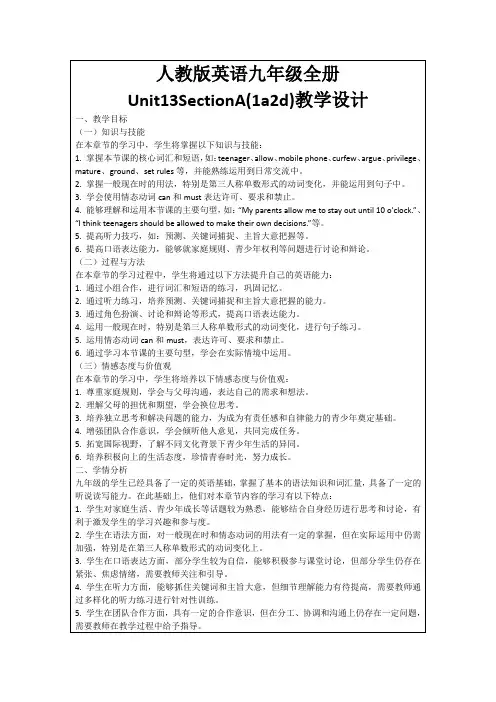
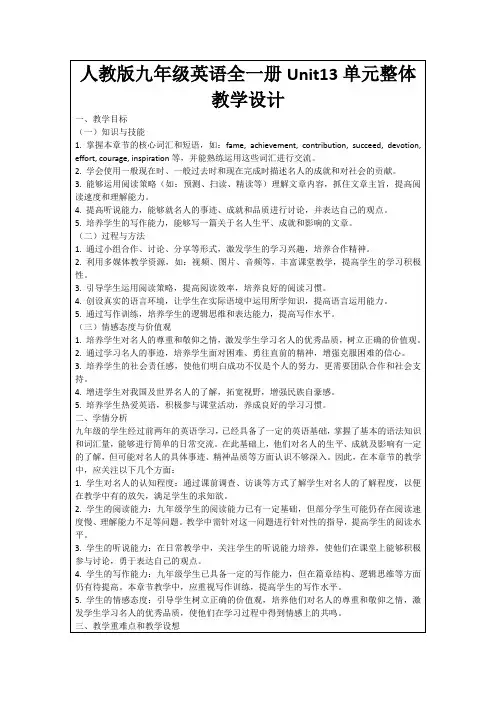
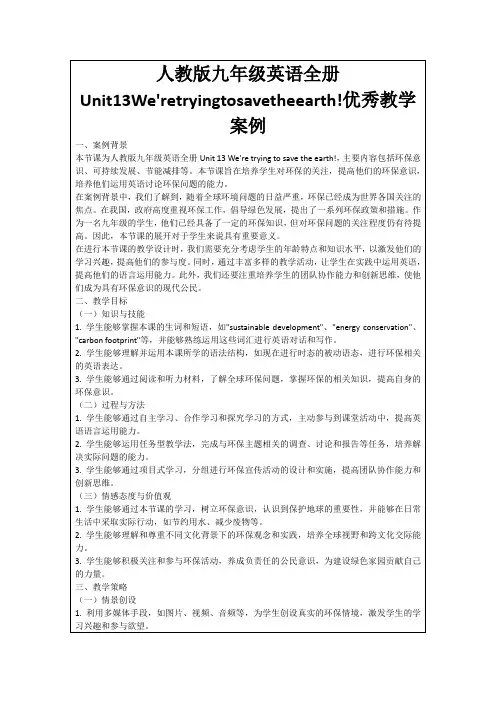
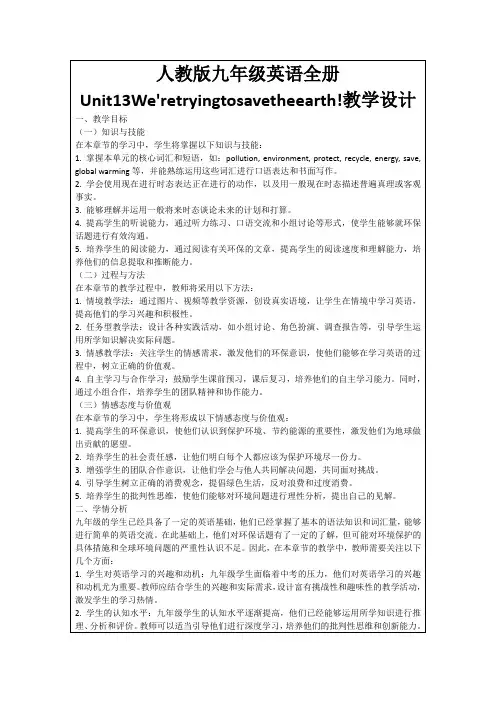
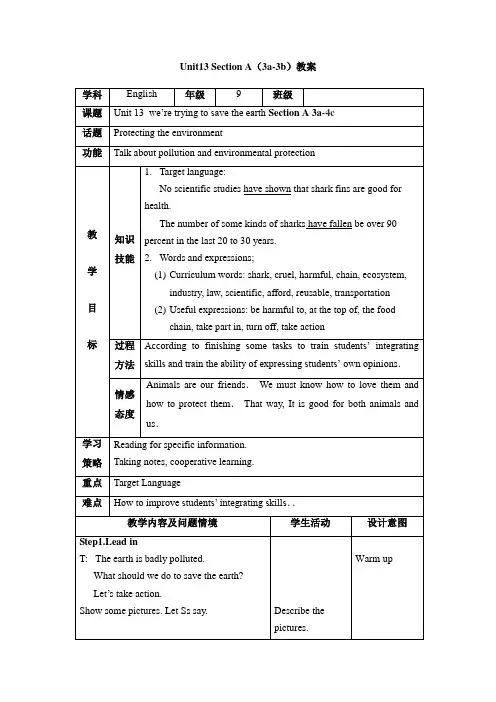
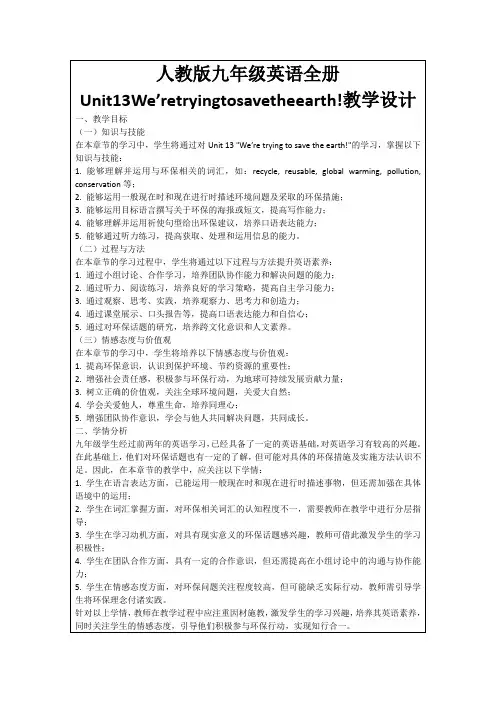
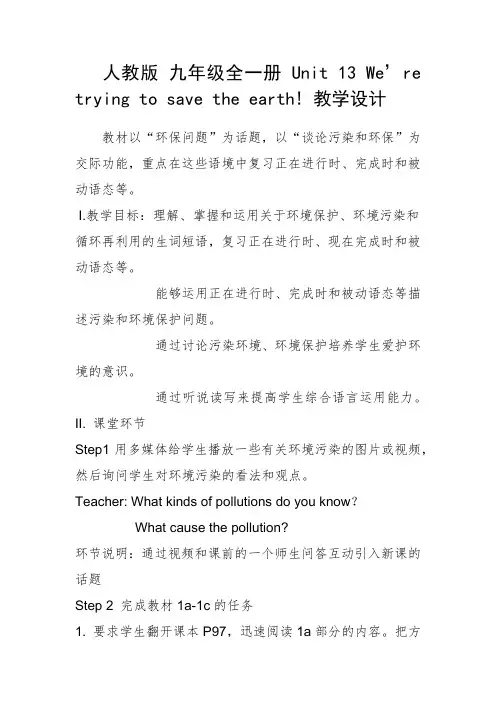
人教版九年级全一册 Unit 13 We’re trying to save the earth! 教学设计教材以“环保问题”为话题,以“谈论污染和环保”为交际功能,重点在这些语境中复习正在进行时、完成时和被动语态等。
I.教学目标:理解、掌握和运用关于环境保护、环境污染和循环再利用的生词短语,复习正在进行时、现在完成时和被动语态等。
能够运用正在进行时、完成时和被动语态等描述污染和环境保护问题。
通过讨论污染环境、环境保护培养学生爱护环境的意识。
通过听说读写来提高学生综合语言运用能力。
II. 课堂环节Step1用多媒体给学生播放一些有关环境污染的图片或视频,然后询问学生对环境污染的看法和观点。
Teacher: What kinds of pollutions do you know?What cause the pollution?环节说明:通过视频和课前的一个师生问答互动引入新课的话题Step 2 完成教材1a-1c的任务1. 要求学生翻开课本P97,迅速阅读1a部分的内容。
把方框中的单词按它们产生污染的类型写入相应的栏目中,并添加更多的单词。
2. 检查答案,先要求全班一起给出答案并检查讨论。
然后要求2-3名同学给出自己的答案,并把收集的答案列举在黑板上。
3. 要求学生听第一遍录音,并根据听到的内容完成课本上1b表格中的句子。
然后要求2-3名同学读答案。
(polluted, rubbish, fish Litter rubbish newspaper, stop, clean)4. 要求学生听第二遍录音,并逐句进行跟读。
5. 完成教材1c的任务,要求学生模仿1a内容,编造自己的关于污染的对话并进行对话练习。
并邀请2-3对同学当堂进行演示。
6. 小结训练。
要求学生在规定的时间内完成一个小练习。
并请若干学生给出自己的答案。
有错误的话及时解决纠正。
用所给词的适当形式填空。
1. There are many kinds of pollutions(pollute)in our daily life.2. All of the students should take part in keeping (keep) our school clean and tidy.3. Can you tell us your ideas for improving (improve) your spoken English.4. W e should stop using the wooden (wood) chopsticks toprotect the forest.5. Their grandparents were fishermen (fisherman) near the sea before they moved to the town.环节说明:通过学习1a,使学生对过去完成时态有所了解,并拓宽了思路;通过1b,锻炼学生的听力及抓取关键信息的能力;通过1c的训练锻炼学生的口头表达能力,同时巩固对本课内容的认识。
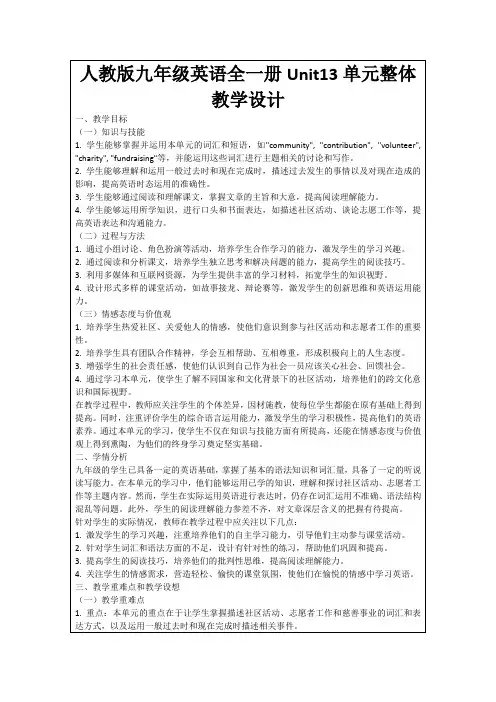
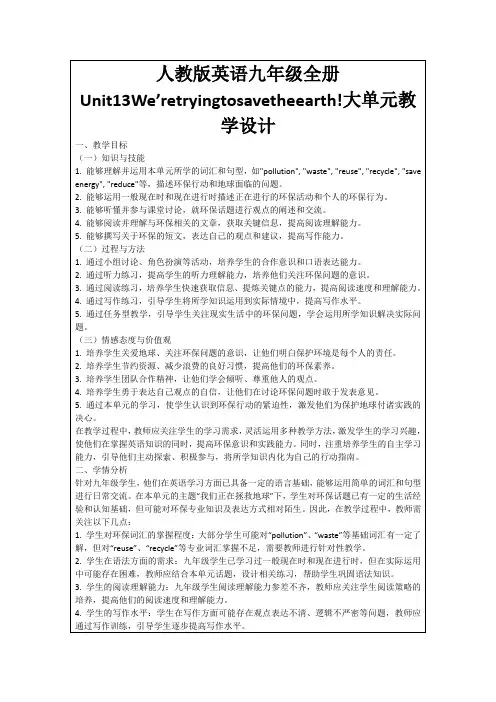
Unit 13 We are trying to save the earth!教学设计这个可怜的人不仅被罚款,而且还被送进了监狱;beharmfulto对…有害;e.g. Smokingisharmfultoth;Playingcomputergamesmuch;电脑游戏玩太多对学生有害;3.Sharksareatthetopofthe;鲨鱼位于海洋生物系统食物链的顶部;at the top of在...最高地位;这个可怜的人不仅被罚款,而且还被送进了监狱。
be harmful to 对… 有害e.g. Smoking is harmful to the health. 吸烟有损健康。
Playing computer games much is harmful to students.电脑游戏玩太多对学生有害。
3. Sharks are at the top of the food chain in the ocean’s ecosys tem.鲨鱼位于海洋生物系统食物链的顶部。
at the top of 在...最高地位; 用最高[最大]的(速度, 声音等)e.g. I looked at the top of his head, his hair shiny and parted s moothly.我看他的头顶, 头发光亮, 分得平滑。
He shouted at the top of his voice in order that he might be hear d.他尽力大声叫喊, 以便别人能听见。
4. If their numbers drop too low, it will bring danger to all oce an life.如果它们的数目降至过低,会给所有海洋生物带来危险。
此句复数形式的number表达全海洋中鲨鱼的总量。
当表示数值的高或低时,number要用high或low修饰。
Unit 13 We’re trying to save the earth!Dajin Middle School : Wu Jingxia一、教学目标:1. 语言知识目标基本词汇:litter, advantage, bottom, fisherman, coal, ugly, cost, wooden, plastic, takeaway, bin, shark, fin, method, cruel. Harmful, chain, ecosystem, industry, law,scientific, afford, reusable, transportation, recycle, napkin, upside, gate, bottle,president, inspiration, iron, work, metal, creativity,基本词组:be harmful to, at the top(of sth.), take part in, turn off, take action, throw away, put sth. to good use, pull… down, bring back基本句型:We’re trying to save the earth!The river used to be so clean.The air is badly polluted.No scientific studies have showed that shark fins are good for health.We should help save the sharks.2. 技能目标: 能正确运用现在进行时,现在完成时,被动语态,情态动词和used to 句型。
3. 情感目标:有环境危机意识,学会关注环境保护环境。
二、教学重难点:1. 教学重点:(1)能正确运用现在进行时,现在完成时,被动语态,情态动词和usedto 句型。
Unit 13 We’re trying to save the earth!Sect ion B 2a--2eRethink, Reuse, Recycle!一、教学目标1、知识目标:掌握课文中出现的一些新词汇和词组表达;根据阅读材料的内容提取要点,实现对文章内容的理解。
2、能力目标:进一步提升学生的阅读和朗读能力。
3、情感态度与价值观:培养学生热爱生活的态度,保护环境意识,提出自己的观点和想法的勇气并鼓励学生将环境保护意识落实到生活实践中。
二、教学过程Step 1 Leading in(1)Read the new words of this part(2)Show a short video about environmental problems to lead in today’s topic------Heal the earth(3)Then review the ways of protecting the environment.Step 2 Reading(1)Pre-reading, show the pictures on the passage to lead in today’s lesson ,find outthe new way to save the earth.(2)Fast readingTask1,listen to the tape carefully and match the main idea of each paragraphTask 2,read paragraph 2 and answer the following questionsTask3 ,read paragraph 3 and answer the following questionsTask4,read paragraph 4 and answer the following questions(3) Careful reading, show a mind map and find more details(4)Post reading, make a interview, A reporter asks Amy Hayes, Jessica Wong, Wang Tao how they think of the unusual ways to make those beautiful things, share their experiences.Then finish the chart on page 102Step 3 summary and homework。
Unit 13 We’re trying to save the earth!
Dajin Middle School : Wu Jingxia
一、教学目标:
1. 语言知识目标
基本词汇:litter, advantage, bottom, fisherman, coal, ugly, cost, wooden, plastic, takeaway, bin, shark, fin, method, cruel. Harmful, chain, ecosystem, industry, law,
scientific, afford, reusable, transportation, recycle, napkin, upside, gate, bottle,
president, inspiration, iron, work, metal, creativity,
基本词组:be harmful to, at the top(of sth.), take part in, turn off, take action, throw away, put sth. to good use, pull… down, bring back
基本句型:We’re trying to save the earth!
The river used to be so clean.
The air is badly polluted.
No scientific studies have showed that shark fins are good for health.
We should help save the sharks.
2. 技能目标: 能正确运用现在进行时,现在完成时,被动语态,情态动词和used to 句
型。
3. 情感目标:有环境危机意识,学会关注环境保护环境。
二、教学重难点:
1. 教学重点:(1)能正确运用现在进行时,现在完成时,被动语态,情态动词和used
to 句型。
(2)保护环境的措施方法。
2. 教学难点:能正确运用现在进行时,现在完成时,被动语态,情态动词和used to 句型。
三、教学步骤:
Section A 1 (1a-2d)
I. Presentation
Show the picture of the earth and tell students the earth is polluted now.
For example: (1) The factories that burn coal pollute the air with a lot of black smoke.
(2) Factories put waste into the river.
(3) People should throw away litter in the bin.
(4)There are more cars on the road.
II. Learning
Here are some words related to different kinds of pollution. Write them in the box below. Then add more words.
loud music cars rubbish planes littering ships factories smoking building houses mobile phones
noise pollution air pollution water pollution
____________ ___________ _____________
____________ ___________ _____________
____________ ___________ _____________
____________ ___________ _____________
Keys : noise pollution loud music planes mobile phones building houses air pollution factories smoking cars building houses。